Mars
Contents
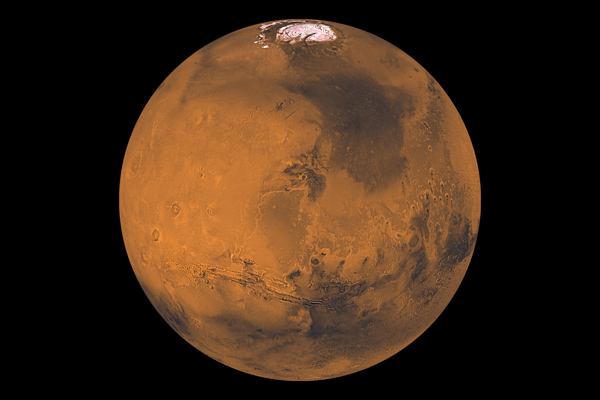 Global Color Views of Mars by Viking / nasa.gov
Global Color Views of Mars by Viking / nasa.govMars, the primary focus of movie makers and storytellers around the world. Exploration and colonization plans have been discussed and implemented since the beginning of the space age. But what do we know of this strange red planet and is it truly mankind's future?
Position to the Sun
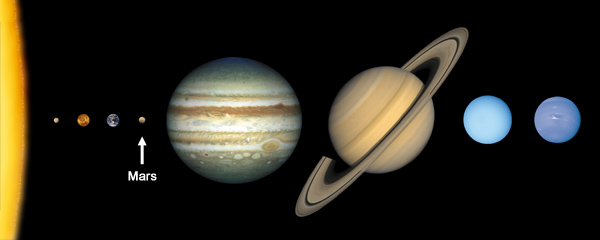 Position of Mars in the Solar System / nasa.gov
Position of Mars in the Solar System / nasa.govThough slightly further than Earth from the sun at an average of 228.5 million km (142 million miles), it has a perihelion at 206 million km (128 million miles) and aphelion at 248 million km (154 million miles). Its elliptical orbit allows for it to have seasons just as Earth has which gives it the same heating and cooling effect of its surface. When at perihelion, its south polar region is facing the sun whereas when during aphelion its north polar region is facing. This is because, like Earth, Mars rotates on an axis (which is at a tilt of 25°). This gives Mars favorable conditions, though not perfect, for the possibility of future colonization.
Mars rotation around the sun takes much longer than the Earth at 687 days versus Earth's rotation of 365. This gives for longer seasons on the surface on Mars than on Earth giving to higher temperatures during the summer and colder temperatures during the winters. Its similarity of seasons to Earth is one of the prime reasons, though, that Mars has been seriously considered as being capable of sustaining a colony on its surface.
Internal Structure
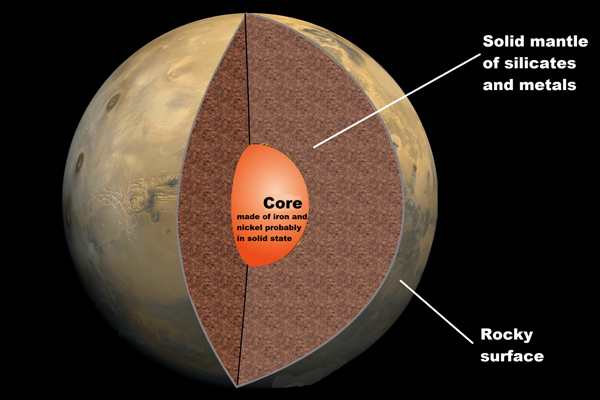 Internal Structure of Mars / nasa.gov
Internal Structure of Mars / nasa.govMars' outer crust is made of a similar basaltic rock as Earth. A fine layer of dust high in iron covers the crust giving the planet it's infamous red coloring, but beneath is a grayish-blue rock. It is believed that Mars may also contain a silicate rock mantle just like Earth's, however, it is not fully known as of yet. Scientist are trying to determine if its core is made up of an iron and nickel compound just like Earth's core or even if Mars' core has the same liquid and solid states or not. With no magnetic field surrounding the planet, there is strong belief that it most likely does not as this would need to be available for the planet to develop a magnetic field.
Surface/Geography
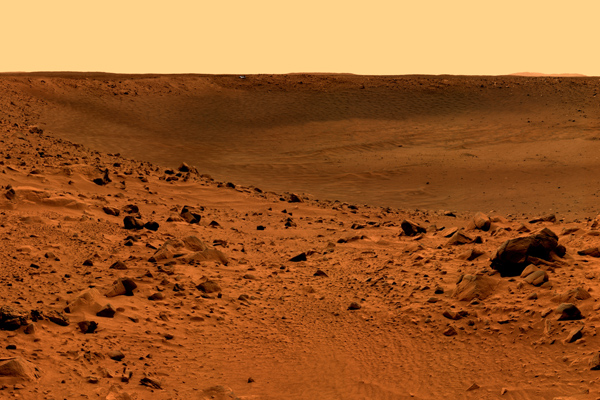 Mars Bonneville Crater in Color / nasa.gov
Mars Bonneville Crater in Color / nasa.govMars' geography is very similar to Earth's and may at one time had contained flowing water on the surface, but billions of years of exposure to solar winds with no magnetic field would have dissipated this water long ago.
However, water still does remain within its polar caps in frozen form and melts periodically to flow across the surface. We can see evidence of this in the run-off lines that stretch across the surface and typographical images show varying minerals littering certain areas that can only be evident with the existence of water. All that is not part of its geography, aside from plant and animal life, is it does not contain oceans. Though recent studies have shown there may be flowing water under the surface that could only have avoided solidification if it were to contain salt, an element typically found in oceans.
Atmosphere/Climate
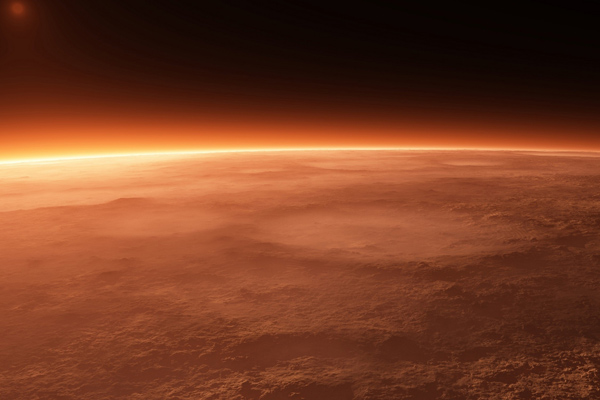 Atmosphere of Mars / nasa.gov
Atmosphere of Mars / nasa.govBecause Mars does not have a magnetic field to protect the planet from the suns emissions, billions of years of bombardment from harmful "solar winds" has stripped away most of the planet's protective layers. All that remains is a thin, unbreathable atmosphere that contains 96% carbon dioxide and only 0.2% oxygen. However, the atmosphere, which is 100 times less dense than the Earth's, does maintain the ability for winds on the surface as well as its axial rotation of 25° giving the planet seasons.
Mars has periods of large dust storms unlike any planet in our solar system has ever seen. These enormous storms can last for weeks and cover continent-sized areas. These storms are so intense, they can be seen via telescopes from Earth and at times (approximately every three years) are known to cover the entire planet. However, they are not as deadly as people may assume by their size. Because of the thin atmosphere on Mars, the highest wind force that would occur would be at approximately 97 km (60 miles) per hour, which is barely half the wind force of a hurricane on Earth.
The dust that covers the planet is very fine and sticks to everything. One article Journey to Mars on the NASA website states "dust particles on Mars are very small and slightly electrostatic, so they stick to the surfaces they contact like Styrofoam packing peanuts". This could cause a huge problem as solar power would be the main source of power on the planet if colonized and the solar panels would need constant cleaning in order to continue to collect the solar rays.
Just like Earth, Mars surface temperatures vary based on location and season on the planets surface. Temperatures range as low as -133°C (-207°F) to as hot as 27°C (80°F) during the summer days. Mars' distance from the sun does not allow it to reach hotter temperatures and there is no greenhouse effect to maintain the heat on the surface, so Mars' high temperatures are pretty moderate.
Mars' Moons
 Moons of Mars: Phobos and Deimos / nasa.gov
Moons of Mars: Phobos and Deimos / nasa.govMars contains two moons which are believed to have been captured asteroids. For more information on these two moons please visit Mars' Moons page.
Exploration
There have been several unmanned missions to Mars starting since the 1960's. Their goal initially was to prove that life existed on the planet's surface. However, once it was determined that no life exist (that we can determine) on the surface, missions slowed to a crawl because funding diminished from the disappointment of not finding life.
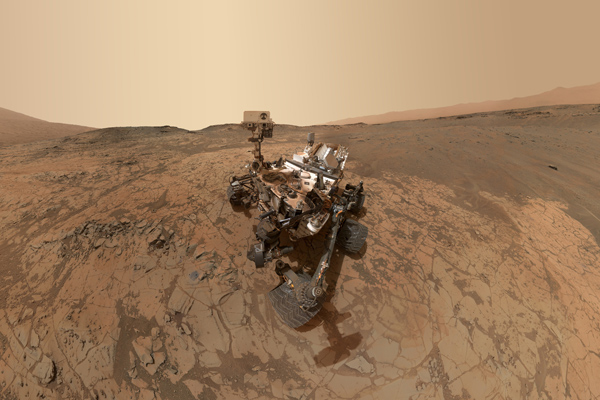 Curiosity Self-Portrait on Mars' Mount Sharp / nasa.gov
Curiosity Self-Portrait on Mars' Mount Sharp / nasa.govDuring the Bush administration, a renewed interest in exploring Mars came about. Now, scientist and civilians alike are interested in the possibility of colonizing Mars in the near future. In the early 2000's, NASA began sending probes to the planet surface to better understand the planet and find a means for it to support human life in the future. The most notable of all landings on Mars would be the rovers Opportunity and Spirit in 2004 and Curiosity in 2011. These 3 rovers still continue to travel the surface of Mars sending back valuable data on this planet to this day.
Today there is a multitude of organizations and governmental entities that are pushing for the colonization of Mars no later than 2020. Theories as to how we can make Mars more livable, such as filling the planet with oxygen-producing microbes, for instance, have been introduced but definitive plans have yet to be finalized. Many projects have sprung up over the last 50 years to send a colony to Mars, some of which are privately run such as the Mars One Project. However, it has yet to be determined if these project will happen anytime soon.
See also: All planets, Objects
Video Gallery

-
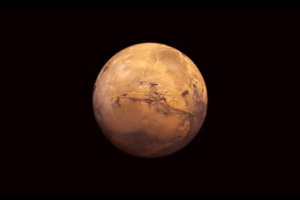 Our Solar System's Planets: Mars
Our Solar System's Planets: Mars
-
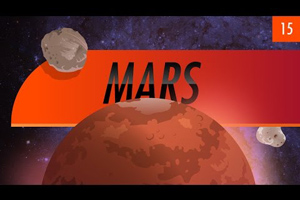 Mars: Crash Course Astronomy
Mars: Crash Course Astronomy
-
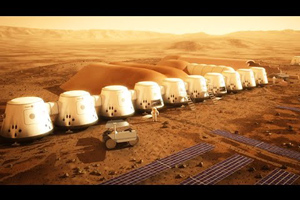 Could Humans Live on Mars?
Could Humans Live on Mars?
-
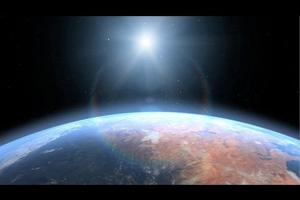 Why Mars Died, and Earth Lived?
Why Mars Died, and Earth Lived?